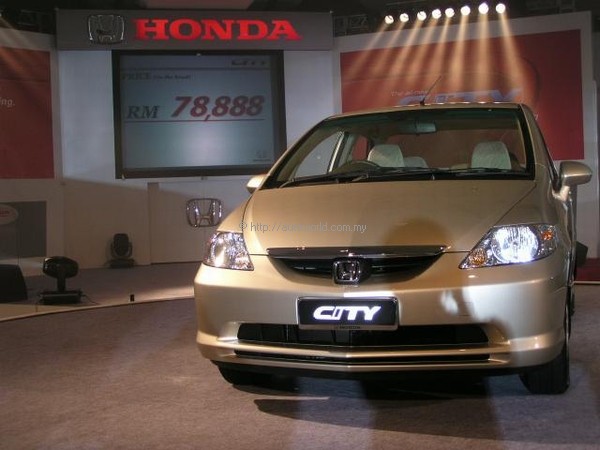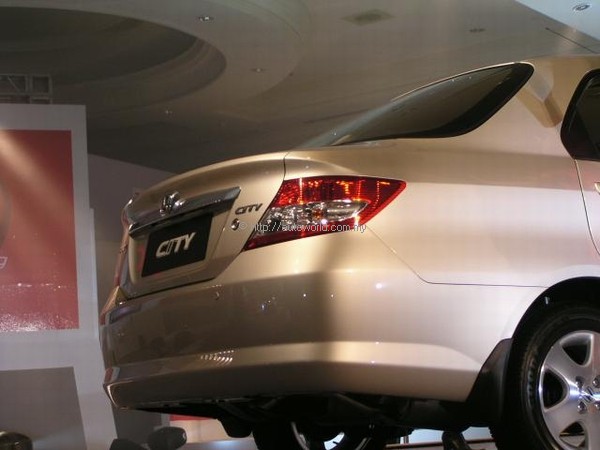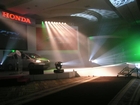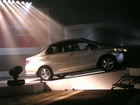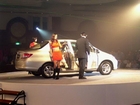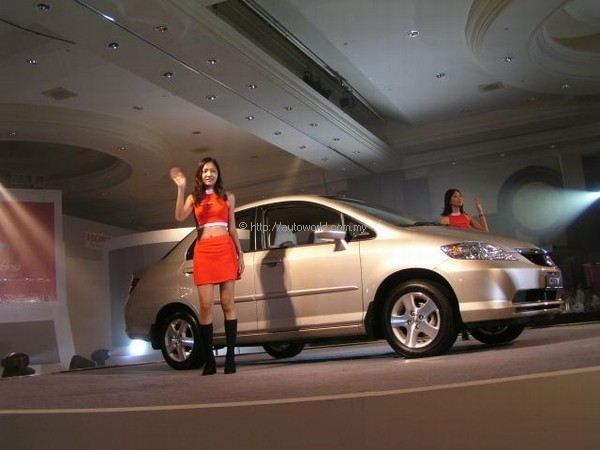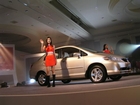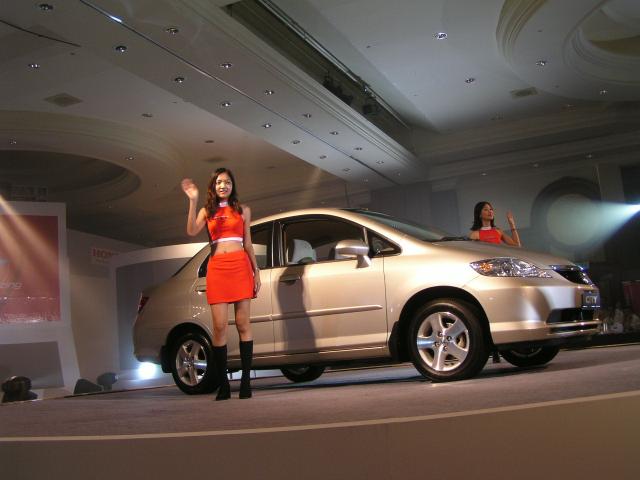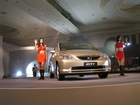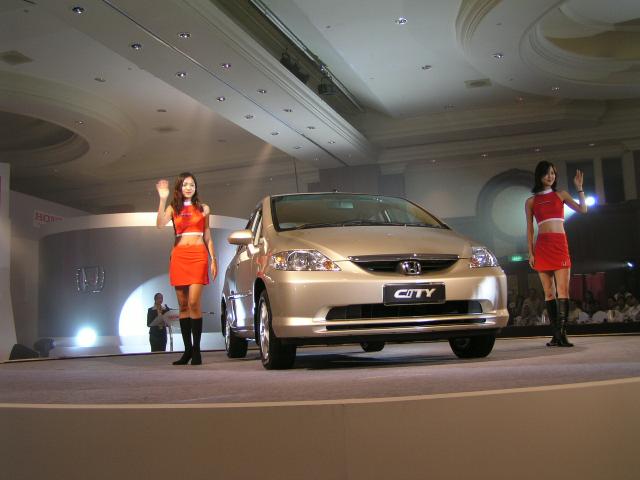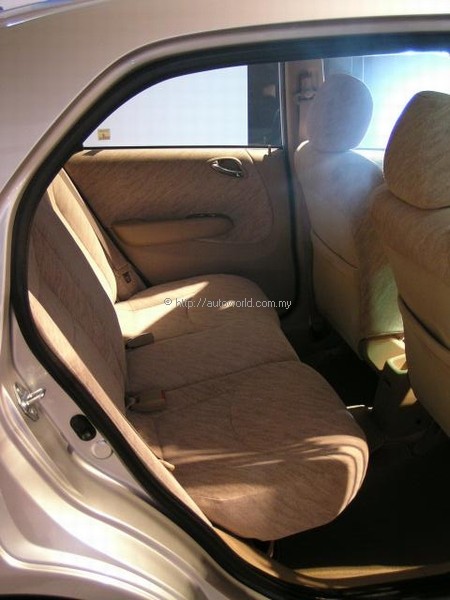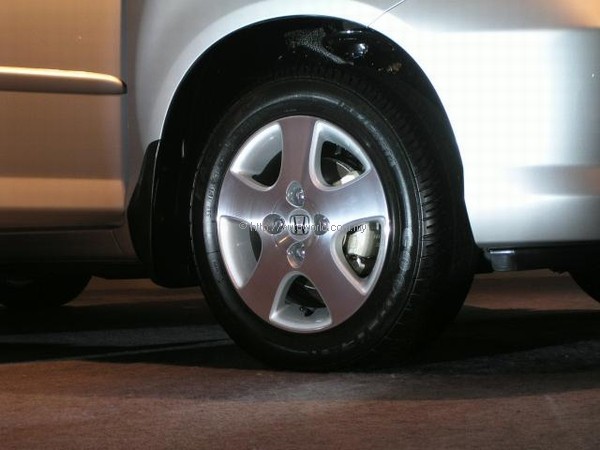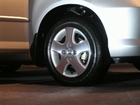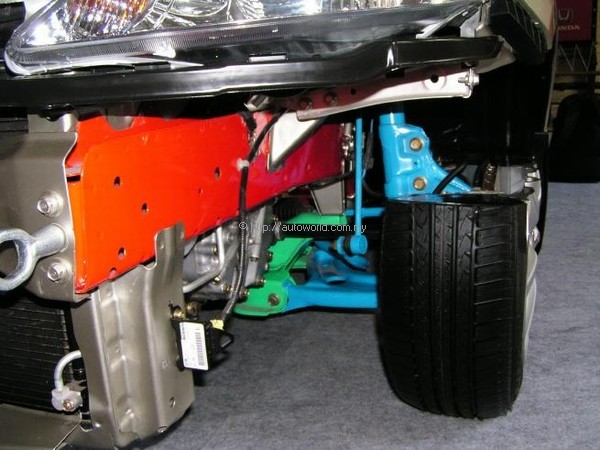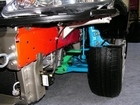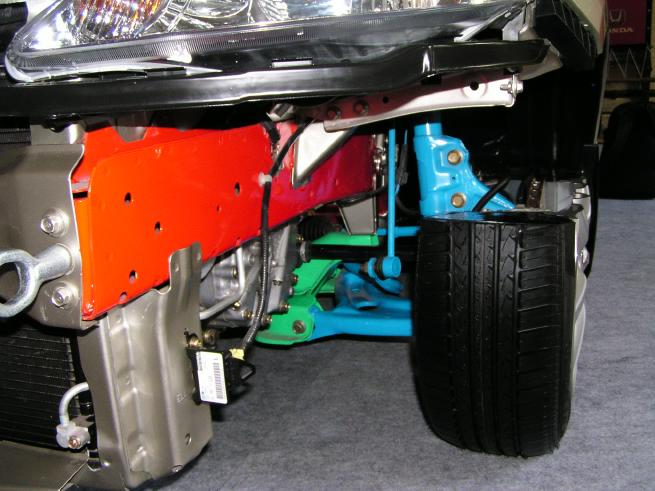New Honda City
RM78,888. On the road.
It’s a sure bet that Honda’s competitors will be echoing the tagline for the new City – Just Amazing. At this price level, the new City should replace the CR-V as the best-selling Honda in Malaysia by year’s-end and most certainly win over those who have been considering Korean makes.
Officially launched today, the new City is the second generation of the ‘Asian Car’ which Honda conceived in 1996. However, as if to reflect a different century, it is a huge change from its predecessor in design, engineering and features. Where the original City was a simpler model, its successor – the second model to be assembled at Honda’s own factory in Pegoh, Melaka – is right up to date in terms of technical excellence.
“The original concept for the City when we introduced it in 1996 was to contribute to motorization in the region and so we focused on affordability,” explained Satoshi Toshida, President/CEO of Asian Honda Motor and also Managing Director of Honda Motor Company Ltd. “That first generation offered the best-value-for-money of any compact sedan and brought an affordable, quality driving experience to the mass market.”
As a result, the City was a popular model regionally and Honda made Thailand its primary manufacturing source. To date, over 200,000 units have been sold in more than 20 countries.
Though it may seem that the six years between the first generation and second generation is an unusually long period when models change every three or four years, Mr Toshida said that the previous generation had actually undergone significant changes within its first few years in response to consumer feedback.
“Officially, this is considered a second generation to the public but personally, I would think of it as a third generation!” he added.
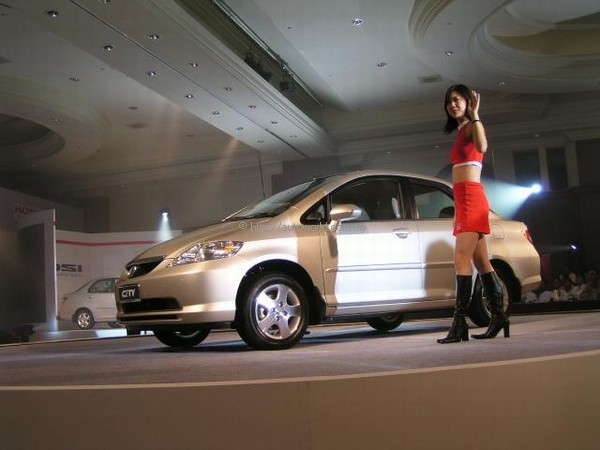 |
This time round, Honda seems to have gone ‘overboard’ in specifications for the City. Apart from an entirely new style, the new City has a lot of technology which would not be expected in a car of this class and especially at this price.
From the platform point of view, the City and the Jazz are like ‘cousins’ but the Jazz is not merely a hatchback version of the City or the City a sedan version of the Jazz. A number of structural elements are different though, for cost reasons, it is clear that there is some sharing of components. Incidentally, about 45% of the components are sourced from ASEAN so this is an AFTA-compliant model and will enjoy the regional tariff benefits when Malaysia lowers it barriers.
As mentioned earlier, a lot of new and advanced technology can be found in the new City and for starters, the i-DSI (Intelligent Dual and Sequential Ignition) engine is from a Honda engine family which is just two years old. While some may be disappointed by the omission of VTEC, Honda engineers feel that the engine’s character will make the absence of the power-enhancing mechanism less of an issue.
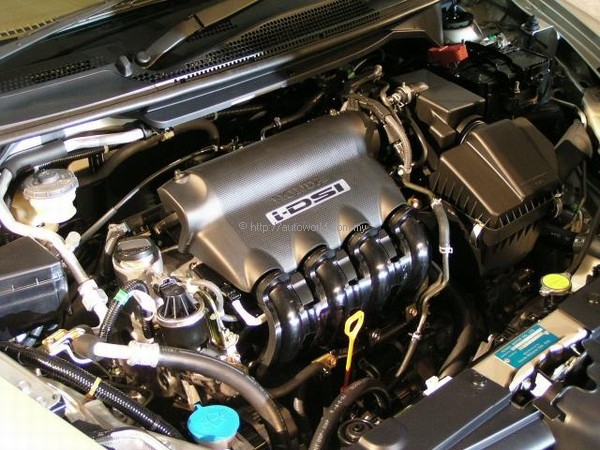 |
In developing the i-DSI engine, the objective was to achieve rapid and complete combustion. Since the Honda CVCC days in the early 1970s, Honda has been a great believer of optimizing the combustion process as a means of achieving high performance, high fuel economy and low toxic emissions. In the i-DSI engine, they would seem to have been able to achieve all three.
Narrower valve angles and other refinements have been employed to make the combustion chambers as compact as possible. The i-DSI engine employs an innovative dual spark plug system (two spark plugs per cylinder), for maximum combustion efficiency. In addition, the combustion chamber has been engineered to promote greater swirl of the air-fuel mixture. The intake manifold shape has also been shaped and its length optimised, while a high compression ratio of 10.5:1 is used.
Other refinements include world-leading friction reduction technology utilizing molybdenum-impregnated piston skirts, a rear-port exhaust system, and an oblique-feed catalytic converter.
And though the 1497 cc long-stroke engine has two valves per cylinder and only a single overhead camshaft, its output is a respectable 65 kW/88 ps at 5500 rpm with 131 Nm of torque peaking at a low 2700 rpm.
The second piece of advanced technology – and a first in the entry-level class locally – is the 7-speed Continuously Variable Transmission (CVT) with Honda Steermatic. For the City and Jazz, Honda has both the 7-speed CVT as well as a normal CVT but Honda Malaysia has chosen to provide the superior 7-speeder as standard.
The operation of a CVT differs from that of a conventional transmission in that there are no individual gear ratios, thus eliminating shift shock and lapses as ratios change. Its like having a single ratio which operates throughout the rev range. The CVT computer continually monitors throttle opening and duration, and automatically changes driving mode for optimum control. It has an optimized belt speed ratio range and direct control of pulley side pressure to enhance transmission efficiency and fuel economy.
While many Malaysians may think of this concept as something entirely new, the CVT has been around for decades but today’s CVTs are a lot more refined and with the use of electronics, efficiency has been heightened significantly.
 |
| 7-speed Honda Steermatic |
The Steermatic feature is something which has been available in much more expensive cars and brings the convenience of pushbutton shifting to the sub-RM100,000 class. It’s an ‘optional’ manual mode which a driver can activate when desired, otherwise the transmission can be left to make the decisions. Having 7 speeds means that there will be a ratio for just about any kind of driving condition you encounter although to many, it must sound daunting after having been used to no more than 4 speeds in automatic transmissions!
Like many new Japanese cars, the City’s suspension has independent MacPherson struts in front (stabilizer included) with a torsion beam layout at the rear. The use of struts at the front is partly because the configuration is proven and universal while allowing a tight turning circle of under 10 metres.
The compact rear H-shaped torsion beam suspension permits a lower cabin floor design, creating more space for rear passengers and baggage. While improving rear wheel-ground contact, the suspension’s oblique-angled trailing arm optimizes side force steer for superb handling stability.
Power assistance for the rack and pinion steering system is from an electric motor, a move which reduces power losses as conventional power-assistance energizers are ‘parasitic’, ie they are driven by the engine.
Standard wheels on the City are 5.5Jx14, with 185/60R14 tyres around them. As with all new Honda models assembled locally, the alloy wheels and tyres are all extensively tested and approved by Honda R&D for compatibility with the model. It is partly for this reason that Honda Malaysia can confidently offer a 36 month/100,000 km warranty with the new City.
The longer warranty is also due to the higher quality in the design and engineering of the body (not to mention the fact that the car is made in Honda’s own factory which has Honda’s superior global quality standards). The body is exceptionally rigid and a notable point is the reduction of noise, vibration and harshness (NVH). Sources of noise and vibration have been tracked down and eliminated, using an efficient combination of vibration-damping material, soundproofing, and insulation. In particular, the doors employ a dual sealing arrangement: a main seal covering the entire door opening perimeter, and a sub-seal installed on the doorside.
The better body construction also benefits safety because it is stronger and it is a crucial aspect of Honda’s G-CON technology. Claimed to achieve the world’s highest standard in crash safety, the new City’s body can withstand a full-frontal barrier collision at 55 km/h; a side offset collision at 64 km/h, side impacts at 55 km/h, and rear collisions at 50 km/h.
To further enhance safety and to meet its own exacting standards of crash safety, Honda also tested the new City in car-to-car collisions. Honda’s car-to-car crashtest is much more rigorous than the standard barrier collision test, and to pass it is proof of extremely good collision safety. Positioning the fuel tank in the middle also provides better protection during collisions while benefiting rear space.
Honda also extends its safety concerns to pedestrians involved in vehicle accidents, extending the focus from head-injury to lower-body injury prevention. This is commendable on the part of Honda and in independent EuroNCAP crash tests, Honda models have been praised for the low degree of injuries caused to pedestrians.
The occupants are, of course, very well protected with dual front airbags and impact-absorbing material around the cabin. The front seats are also constructed in such a way that neck injuries are less likely because an impact in the next area is equally distributed to the head and torso.
As for Active Safety, the City’s disc/drum brake system has ABS and EBD for optimum stopping power, even in slippery conditions. Brake Assist is also incorporated in the programming and this feature kicks in during emergency braking by boosting braking pressure automatically. It was introduced after researchers found that many motorists, especially older ones and also women, did not apply maximum braking pressure and thus did not get the full capability of the brake system.
Cabin features are also going to please many owners though this is not surprising since Hondas have often had clever features to make motoring more enjoyable. It has an Ultra Seat layout for the rear which is an adaptation of the one in the Jazz. According to a Honda Malaysia executive, this feature is not cheap and it reflects Honda’s keen desire to give customers better value for money.
The Ultra Seat (now being nicknamed ‘Origami Seat’ because of its unique folding features!) has a Utility Mode which is like what you have in many sedans (though some have omitted it now) – the rear backrests can fold down flat to extend the boot length. For much longer items, the front seat backrest can be folded back flat. The 60:40 division of the rear backrests allows flexibility in carrying people and cargo.
The most unique position is the Tall Mode where the rear seats can be folded up against the backrests so there is the extra depth available to carry something like a plant. It’s a great idea which other companies will no doubt be trying to copy before long. For safety, the folded seats are locked firmly in place.
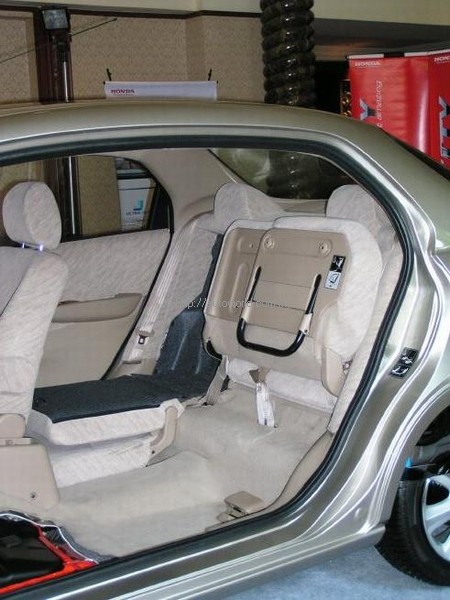 |
| Ultra Seat in ‘Tall Mode’ |
Other amenities in the City include dual glove boxes at the front, dual front cupholders, adjustable front seat height and grocery bag hooks under the rear seats which are accessible when the seats are folded up. For added security, the ignition key is a ‘wave’ type rather than the conventional type and there is an engine immobiliser included as standard.
Seiji Kuraishi, MD/CEO of Honda Malaysia, is expecting the new City to sell in excess of 5,000 units this year, close to half of the total Honda sales forecast for 2003. He revealed that at least 500 Malaysians have already booked the new model without knowing its price and as there are 500 units already produced, delivery time will be almost immediate.
While considering the Toyota Vios, also to come into the market soon, as a rival, Mr Kuraishi feels that the City should present a bigger threat to Korean makes. He acknowledges that the Koreans have grabbed some market share – Kia overtook Honda last year – but thinks that their gains will be sort-term.
“We have watched the Korean strategies in many markets and we believe that when it comes to quality, customers will understand that there is a difference when they drive a Honda and we urge them to try our new City to confirm this,” he told AUTOWORLD.COM.MY.
Media test-drives are to take place in May so come back later on and we’ll tell you how this new Honda goes. But then again, it’s a Honda and quite frankly, we would expect the same sort of excellence that past Hondas have shown.



